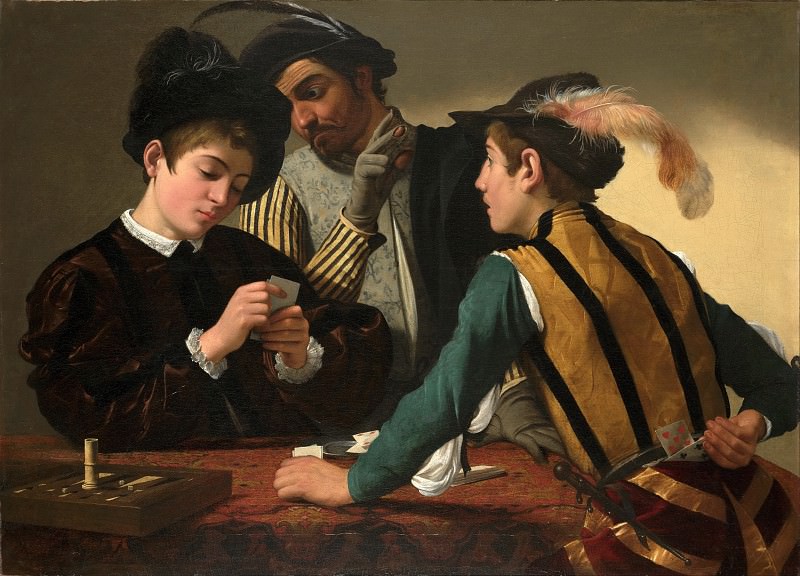Cardsharps Michelangelo Merisi da Caravaggio (1571-1610)
Michelangelo Merisi da Caravaggio – Cardsharps
Edit attribution
Download full size: 4501×3239 px (3,4 Mb)
Painter: Michelangelo Merisi da Caravaggio
A master of realistic Baroque paintings, Caravaggio narrates life around him in his masterpieces without a hint of reproach. In one of his 1596 canvases, titled Cheaters, the Italian painter shows a scene of petty card cheating. Such actions were commonplace for society at the time, an obvious amusement. The composition of the image is built according to classical canons. Three male figures are located in an imaginary triangle.
Description of Caravaggio’s painting "Cheaters
A master of realistic Baroque paintings, Caravaggio narrates life around him in his masterpieces without a hint of reproach. In one of his 1596 canvases, titled Cheaters, the Italian painter shows a scene of petty card cheating. Such actions were commonplace for society at the time, an obvious amusement.
The composition of the image is built according to classical canons. Three male figures are located in an imaginary triangle. Such a technique facilitates perception and makes the picture very balanced.
On the right side of the table we see a young boy calmly looking at his cards. The handsome young man’s face is bright and somewhat naive. The other two participants in the old-time poker game are accomplices.
A man of mature years is behind the boy who is gazing at the deck. He reads the suits with a tenacious eye and shows the secret signs on his fingers to the younger player. His gloves show scraps of cloth cut off to make it easier to feel the cards.
The second cheater prepares to pull the prepared cards from a slit in his clothes. He deliberately misleads his fellow poker player with a silly, distracted look. So you want to know how the game played out next. Was the deception successful? Was not upset trusting boy?
The artist paid a lot of attention to the elaboration of costumes. The deceivers are dressed in motley, striped clothes, which makes them look like jesters. On their hats are puffed bird feathers.
The background is neutral and beige. He has a large sunlit area clearly visible on the background. In general, the canvas "The Cheater" has a lot of light and few dark areas. By abandoning dramatization, Caravaggio writes a hymn to the merry feast and game. But we, the viewer, are nevertheless saddened by the deception: he urges us to be more circumspect in life.
Кому понравилось
Пожалуйста, подождите
На эту операцию может потребоваться несколько секунд.
Информация появится в новом окне,
если открытие новых окон не запрещено в настройках вашего браузера.
You need to login
Для работы с коллекциями – пожалуйста, войдите в аккаунт (open in new window).




















You cannot comment Why?
On the left, a fair-skinned youth in a dark velvet tunic and a feathered hat holds his cards, seemingly engrossed in his hand. His expression is one of concentration, but theres a hint of vulnerability or naivety.
Behind him, an older man with a dark beard and a stern expression leans in, whispering into the ear of a third young man. He wears a checkered patterned vest and a cap with a feather. His gloved hand is raised, with his index finger raised as if giving a signal or imparting crucial (and likely dishonest) information. His eyes are wide and alert, observing the scene unfold.
On the right, another young man dressed in a striking yellow and black striped vest over a green shirt, leans forward. His gaze is directed towards the first youth, his expression a mixture of anticipation and perhaps a touch of malice. Crucially, tucked into his bandaged back pocket, he surreptitiously holds a set of cards, arranged to be slipped to the first player, betraying the cheat. A dagger also rests tucked into his elaborate sash.
The subtext of the painting is evident: its a narrative of deceit, betrayal, and the exploitation of innocence. The opulent attire of the figures suggests they belong to a privileged class, making the act of cheating even more of a social transgression. The painting captures a moment of impending trickery, highlighting the subtle cues of conspiracy and manipulation. The contrast between the youthful innocence of the player on the left and the conspiratorial glances and hidden cards of the others creates a palpable tension, suggesting a lesson in caution and awareness of hidden dangers, particularly in the realm of gambling and duplicitous human behavior. Its a scene that speaks to the darker aspects of human nature, where trust can be easily broken for personal gain.